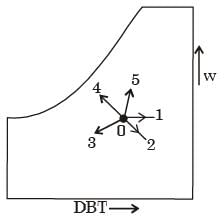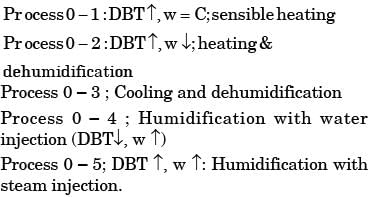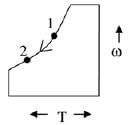Past Year Questions: Psychrometric Process - Mechanical Engineering MCQ
10 Questions MCQ Test Additional Study Material for Mechanical Engineering - Past Year Questions: Psychrometric Process
Wet bulb depression, under saturated ambient air conditions:
[1989]
During the Chemical dehumidification process of air
[1999]
| 1 Crore+ students have signed up on EduRev. Have you? Download the App |
Water at 42°C is sprayed into a stream of air at atmospheric pressure, dry bulb temperature of 40ºC and a wet bulb temperature of 20°C. The air leaving the spray humidifier is not saturated. Which of the following statements is true?
[2005]
Various psychrometric processes are shown in the figure below.
Process in Figure
P. 0-1
Q. 0-2
R. 0-3
S. 0-4
T. 0-5
Name of the process
(i) Chemical dehumidification
(ii) Sensible heating
(iii) Cooling and dehumidification
(iv) Humidification with steam injection
(v) Humidification with water injection

The matching pair are
[2005]
Dew point temperature is the temperature at which condensation begins when the air is cooled at constant
[2006]
The statements concern psychrometric chart.
1. Constant relative humidity lines are uphill straight lines to the right.
2. Constant wet bulb temperature lines are downhill straight lines to the right.
3. Constant specific volume lines are downhill straight lines to the right.
4. Constant enthalpy lines are coincident with constant wet bulb temperature lines.
Which of the statements are correct?
[2006]
Atmospheric air at a flow rate of 3 kg/s (on dry basis) enters a cooling and dehumidifying coil with an enthalpy of 85 kJ/kg of dry air and a humidity ratio of 19 grams/kg of dry air. The air leaves the coil with an enthalpy of 43 kJ/kg of dry air and a humidity ratio of 8 grams/kg of dry air. If the condensate water leaves the coil with an enthalpy of 67 kJ/kg, the required cooling capacity of the coil in kW is
[2007]
Air (at atmospheric pressure) at a dry bulb temperature of 40°C and wet bulb temperature of 20°C is humidified in an air washer operating with continuous water recirculation. The wet bulb depression, the difference between the dry and wet bulb temperatures) at the exit is 25% of that at the inlet. The dry bulb temperature at the exit of the air washer is closest to
[2008]
Moist air at 35°C and 100% relative humidity is entering a psychrometric device and leaving at 25°C and 100% relative humidity. The name of the device is
[2014]
If a mass of moist air contained in a closed metallic vessel is heated, then its
[2017]
|
1 videos|30 docs|57 tests
|
|
1 videos|30 docs|57 tests
|
























